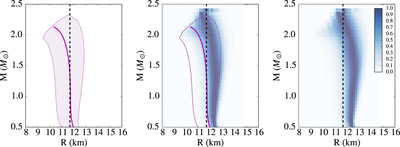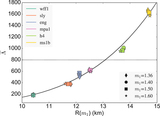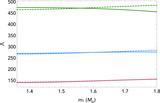Image Details

Caption: Figure 3.
Left: mass–radius relations corresponding to the most-likely EOS in our Bayesian inference, with a sample distribution for ﹩\widetilde{{\rm{\Lambda }}}﹩ centered at ﹩\widetilde{{\rm{\Lambda }}}=400﹩ and a fixed chirp mass of ﹩{{ \mathcal M }}_{c}=1.188\,{M}_{\odot }﹩. The solid magenta line corresponds to the most-likely EOS, while the pink band corresponds to the range of EOS with posteriors within ﹩1/\sqrt{e}﹩ of the maximum value. The black dashed line shows the analytic prediction from our ﹩\widetilde{{\rm{\Lambda }}}﹩ – R relation of Equation (9). We find excellent agreement between our ﹩\widetilde{{\rm{\Lambda }}}﹩ – R prediction and the full Bayesian inference. Middle: same as the left panel, but showing, in addition, the marginalized posteriors over the neutron star radii for a fixed grid of masses. These marginalized likelihoods are shown in blue. By marginalizing the posteriors in this way, the results are skewed to higher radii and away from the maximum-likelihood solution. Right: marginalized likelihoods for an inference with only the priors and no data. These marginalized posteriors are nearly identical to the marginalized posteriors from the inference that incorporated data from a ﹩\widetilde{{\rm{\Lambda }}}=400﹩ centered Gaussian. This method of marginalization overweights the prior on the EOS pressures imposed by the observation of a 1.97 ﹩{M}_{\odot }﹩ neutron star. The results of the marginalization are less sensitive to the input data and are not reliable.
Copyright and Terms & Conditions
© 2018. The American Astronomical Society. All rights reserved.





